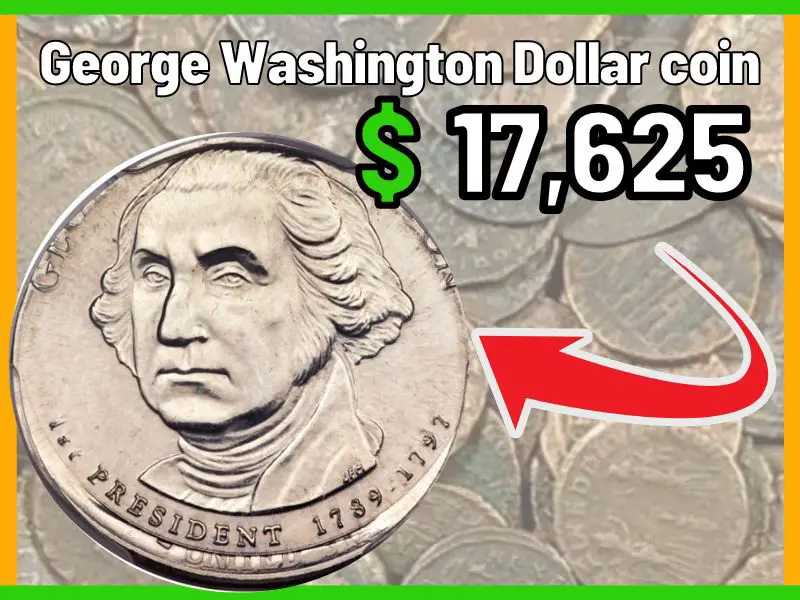
A George Washington Dollar will sell at its face value of $1 in uncirculated condition. This is because this coin isn’t particularly rare. In fact, it’s so common that you might find a piece when rummaging through pocket change.
That notwithstanding, these coins can actually sell at premium prices under the right conditions.
If you’ve been wondering how much a George Washington Dollar is worth in various conditions, then you’ve come to the right place. Keep on reading this article to find out.
Most Valuable George Washington Dollar coin
The Most Valuable George Washington Dollar coin was Sold on Jan 6, 2016 for: $17,625.00
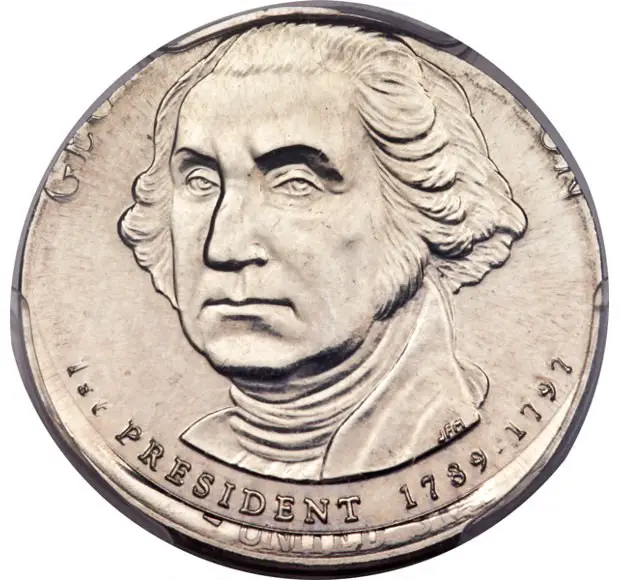
The George Washington Dollar coin
George Washington was the first president of the United States, so it only makes sense that his face will be one of many to grace the presidential dollar coins. These coins are not rare in any way as they were mass produced and circulated from the initial day of production, which was 2007 to 2011.
Of course, the mass production resulted in a stockpile of unused one dollar coins. That’s why these coins have a low resale value because collectors can find or acquire them easily.
History
In 2005, Senator John E. Sununu proposed the presidential $1 presidential coin act on the 17th of May. It was met with a large number of supporters as he had over 70 co-sponsors on his side when this act was introduced.
The Presidential $1 Coin Act of 2005, or as it was also known as “The Presidential $1 Coin Program”, was a program that sought to issue coins from four past presidents of the United States per year on the obverse side of the coin with the Statue of Liberty on the reverse side.
With the failure of the Sacagawea $1 coin to gain widespread circulation in the United States, this Act was introduced to prevent such from happening again. Also, it was a way to honour and educate the nation about the country’s past presidents.
The plan was to issue one for three months before moving on to the next president in chronological order and by their term in office. This would ensure that they honour as many past presidents as possible.
Only presidents two years before the time of minting were eligible; thus, George Washington became the first president on the obverse side of these series.
The George Washington $1 coin became available to the public on February 15, 2007, in honour of Presidents’ Day.
Features
This coin had a composition of 88.5% copper, 6% zinc, 3.5% manganese, and 2% nickel, with a weight of about 8.1 grams.
One of the many interesting features of the George Washington one dollar coin is that it has its mint mark on the edge of the coin just after the year. This is different from most coins minted in the United States that have their mintmarks on the obverse side.
Also, it has a shiny gold-like lustre and is considered part of the United States coinage “Golden dollars”.
Obverse
The coin’s obverse features a portrait of the late president George Washington designed by Joseph Menna. He was a medallic artist and the first full-time digitally skilled artist hired by the United States. The portrait was his first design for the United States Treasury.
Asides from the portrait of George Washington, the coin also has the following inscriptions
- “George Washington”, which is above the portrait of the president.
- “1st president”, which is below the George Washington’s portrait.
- “1789 – 1797” indicates the years George Washington spent in Office. This inscription is also below Washington’s portrait next to the one mentioned above.
Joseph Menna also has his initials on the obverse of the coin right on the portrait of George Washington. You will find it around the late president’s collar.
Reverse
Like other coins on the presidential $1 coin series, the coin’s reverse has the Statue of liberty struck at its centre. Don Everhart, who is a Sculptor and Engraver, is reputed to be the one responsible for the design.
Right in front of the Statue of liberty is the denomination “$1,” and the inscription “UNITED STATES OF AMERICA” circles around the coin, cutting through Liberty’s raised arm.
Edge Lettering
The Washington Dollar has an edge lettering which is the year of the coin’s minting inscribed onto its edge, providing a unique issuance to the coin.
Edge lettering on coins goes as far back as the 1790s, and it started as a way to discourage the shaving off of gold coin edges, formerly practised to cheat payees.
Prior to the presidential coins, the last time edge lettering was practised in the United States was during the production and circulation of Gaudens Double Eagle (1907–1933).
The dates weren’t the only part of the George Washington edge lettering, its mint mark as well as the inscription “E PLURIBUS UNUM” and “IN GOD WE TRUST”, which was later replaced in 2009 by the 13 stars, representing the original 13 states that declared independence from the British, were also struck on the coin’s edge.
You will find the arrangement of the edge of the coin goes in the following order “2007 D. E PLURIBUS UNUM. IN GOD WE TRUST.”
One would notice that the inscription liberty is absent from the obverse, reverse and even the edge of the coin. This was a decision made as they felt it was redundant considering the image of the Statue of liberty was on the reverse of the coin, and they felt it sufficed in conveying the message of liberty.
Mints and Varieties
The Washington Dollar was the first in the series of presidential $1 and had the highest mintage of the series. It also featured a significantly high number of errors that made it into production and got introduced to the public.
Many collectors considered this the adjustment period as many mints were trying to get used to the reintroduced edge lettering.
The Washington Dollar was minted in vast amounts with millions of coins released into circulation, so much so that there are now thousands of the coins lying unused in bank vaults.
Three Major mints, Philadelphia, Denver and San Francisco, were responsible for most of the coins that were released into circulation.
2007P George Washington Dollar
The Philadelphia mint was responsible for the George Washington Dollar coins that bear the 2007 P mint mark, indicating the location of the mint that struck them.
With a total of 176,680,000, the Philadelphia mint struck the highest number of coins. That’s 13 million coins more than the total coins struck at Denver.
2007D George Washington Dollar
Denver had the second highest mint and produced 163,680,000 coins in total. The letter D is the mintmark that makes recognising coins struck at this facility easy.
2007S Proof George Washington Dollar
The 2007S George Washington Dollar coin was the first proof in the presidential dollar series. As such, these coins were slightly different from the standard ones released into circulation. The Mint struck just 3,965,989 in total.
A major difference was that the inscriptions “IN GOD WE TRUST” and “E PLURIBUS UNUM” as well as the date, among other attributes. The edge lettering was applied by a Schuler edge lettering machine.
The coins were sold in sets of four a piece. And each set contained a proof presidential dollar coin with a portrait of late Presidents George Washington, John Adams, Thomas Jefferson and James Madison. Since they were struck at the San Francisco mint, they all carry the ‘S’ mintmark, indicating the mint’s location.
The 2007 presidential proof set was offered for sale directly from the Mint for $14.95 per set and was available to collectors on June 2007.
Errors
The George Washington Dollar coins were released into circulation with a staggering amount of errors. Such was the popularity of the errors that the public started looking out for them in their one dollar coins.
Collectors attributed the vast amount of errors to mints still trying to reintroduce the edge lettering to the coins.
Here are the errors that were found on the George Washington Dollar coins:
Godless Dollars
They are known commonly as godless dollars due to the missing inscription “IN GOD WE TRUST” that was supposed to be on the edge with other inscriptions with the others.
When the first issue of the coin was released, people immediately spotted the plain edge of the coin. This coin was missing its edge lettering. And on February 25 2007, the same day of release, it was sold for $612 on eBay.
People started to search for George Washington Dollar coins with this defect frantically, and it was estimated that about 200,000 of these coins were minted and in circulation. Due to the vast number minted, the price of coins bearing this shocking defect dropped to $20-$30.
However, grading companies refer to them as missing edge lettering coins.
Another worthwhile thing to note is that since the edge lettering is missing, many people can’t ascertain what mint produced these defective coins. There are some speculations based on colours, but these were never approved.
Pez Head
These coins are also known as the severed head error because Lady Liberty is missing some parts of her neck
The line that indicates the front of her neck is missing, making her neck look like a pez dispenser.
It’s believed that this error was caused by over-polishing the coins’ reverse sides.
Star Burst
These errors had streaks coming out of George Washington or Lady Liberty’s head. They radiate towards the rim almost like a halo or, in this case, a starburst.
Double Edge Lettering
Some Washington Dollar coins were discovered to have double edge lettering. Mints sometimes ran through the edge lettering process twice, resulting in two completely separate letterings.
Faceless Dollars
These are the opposite of Godless dollars. Coins with these errors only had their edge lettering present with the obverse and/or reverse side completely blank.
Upside Down Edge Lettering
Numismatists believe that there was initially a correct orientation for edge lettering. However, after the process of minting these coins was described, it’s now believed that the minting process is completely random, and half of the coins minted will have a “correct” orientation, and others will be upside down.
Other Flaws
Many other errors were found on the George Washington coins, including various die errors or coins that were not properly annealed.
How Rare is The George Washington Dollar?
Millions of George Washington Dollar coins are in circulation today, meaning these coins are not rare. Although the San Francisco mint, which struck the lowest number of coins among the major mints, produced 3,965,989 Washington Dollars, the others produced over 100 million of the coins individually.
This means that most of the George Washington Dollar coins you’ll find won’t fetch much and will only sell at face value.
However, some varieties are considered rare, and you can sell these rare varieties at premium prices and higher prices in return. These coins are either the ones bearing an error or having higher grades.
Factors that Affect a Coin’s Rarity
Rare coins are extremely valuable, and more often than not, certain factors influence their availability and rarity among collectors.
So here are the most important factors responsible for a coin’s rarity.
Mintage
A coin’s mintage simply means the total amount produced. This is usually the most important of the factors that determine a coin’s rarity and value.
Coins like the Washington Dollar have a total mintage of over 300 million and as a result, they’re in no way considered rare.
However, other coins that are also known as limited edition coins weren’t widely produced and as a result, it will be very difficult to get your hands on them. These coins are rare and very valuable.
Demand
Demand comes into play when the mintage of specific varieties of a coin is low or if the coin is limited.
This makes more people especially collectors look for it, and the more people want a particular coin, the rarer it becomes because it is no longer in being and, therefore, has a fixed amount available.
Coins that are in high demand are considered rare because everybody wants them. Demand works hand in hand with mintage, or you can say they’re inversely proportional because with higher mintage comes lower demand and vice versa.
George Washington Dollar Coin Value
The George Washington Dollar is not particularly valuable because of its high mintage and availability. In fact, it had such a high mintage that some of the coins are still unused.
As such, they only go for their amount in face value, and that’s $1 in circulated condition. However, the coins sell for higher in premium conditions.
For example, the George Washington Dollar that was minted in both the Philadelphia mint and the Denver mint are worth around $4 in MS 65 grade.
The San Francisco proof George Washington dollar coin is worth around $11 in PR 65 condition.
Coins in these grading conditions are almost perfect, with only a few scratches on the surface.
Factors that Influence a Coin’s Value
A coin’s value is determined by various factors that include its features, physical attributes, and rarity.
These factors can alter the value by potentially increasing the coin’s importance or uniqueness/attractiveness to collectors.
Grade
The Sheldon Numerical Scale is a popular grading system used to ascertain a coin’s value based on the coins appearance.
Coins are graded on a scale that ranges between 1-70, with 1 being the worst state of that bill and 70 being a perfect mint state.
Using this system, coins can be grouped into categories such as good, fine, extremely fine, and mint or uncirculated condition.
The coins in uncirculated conditions are the most valuable, and they sell at very high prices.
Presence of an Error
A coin with a rare error can sell for a very high amount. The reason is that this error makes the coin unique, increasing its appeal to collectors across the world.
However, the Washington Dollar coins had several errors, so much so that the value of the error coins dropped.
It is important to note that most of them still sell at higher prices than standard varieties.
Demand
The higher the demand of a coin the greater its value.
However, the George Washington Dollar coin was produced in millions, so they’re not in high demand, but premium coins or coins with specific errors still appeal to several collectors.
Prices
MS 64 |
MS 65 |
MS 66 |
PR 69 |
PR 70 |
|
2007 D Washington Dollar |
$9.95 |
_ |
_ |
_ |
_ |
2007 S Washington Dollar |
_ |
_ |
_ |
$5.79 |
$23.95 |
2007 P Washington Dollar |
$9.95 |
_ |
_ |
Where to Sell Your George Washington Dollar coin
As we mentioned earlier, the George Washington Dollar coin is not rare nor is it very valuable that’s why if you’re looking to sell one in your possession, it is vital to know where to sell it to get the best price.
For example, you can walk down to any pawn shops or coin dealers In your neighbourhood and they can buy your Washington Dollar (depending on its condition) for $1 in good condition or more if it’s in extremely fine condition. An uncirculated coin might be higher, as some have been sold for $50.
Fortunately, those aren’t your only option. Online platforms also provide excellent possibilities for you to get the best value for your coin.
Shopping websites like eBay and Heritage Auctions are popular choices among people looking to build coin collections. However, there are other online platforms like Etsy among others. These alternatives will also work fine.
Don’t forget to get a coin appraisal from a professional to ensure you’re getting the best value for your coin.
Although an online shop is where the money is, pawn shops are best when it comes to accessibility and other factors like selling for quick cash. This is why they serve as good choices for low-value coins.
FAQs
Is there a $1 George Washington coin?
Yes, the $1 George Washington coin was part of the $1 presidential coin series. In fact, it was the first released coin belonging to the series.
Are George Washington dollar Coins Worth Anything?
The George Washington Dollar is worth a face value amount of $1 in circulated condition. The reason for such a low amount is that they are neither rare nor valuable. But they can be sold for higher in better condition.
How Many Presidential $1 dollar Coins are There?
The United States Treasury Department said that there is over a 1.4 billion surplus on $1 coins in the federal reserve.
Are They Still Making Presidential Dollar Coins?
In 2016, Geithner directed that all mints cease production of the presidential dollar coins.
This is because of the surplus of coins in the federal reserve.
Were any of the Washington Dollar coins produced with Errors?
There was a stupendous amount of Washington Dollar coins with errors. Many of these errors sold for hundreds of dollars at the time the coin was released.
However, the value for error coins dropped when people discovered how common they were.
Wrapping Up
The presidential $1 program was a commendable effort by the United States to honour past presidents as well as educate the public on the nation’s former leaders. George Washington Dollar being the first president also ensured that he was featured in the series.
Unfortunately, these coins were not as popular as they were expected to be, and they came with many defects.
Still, they’re a worthy find as the George Washington Dollar is a great addition to any collection.

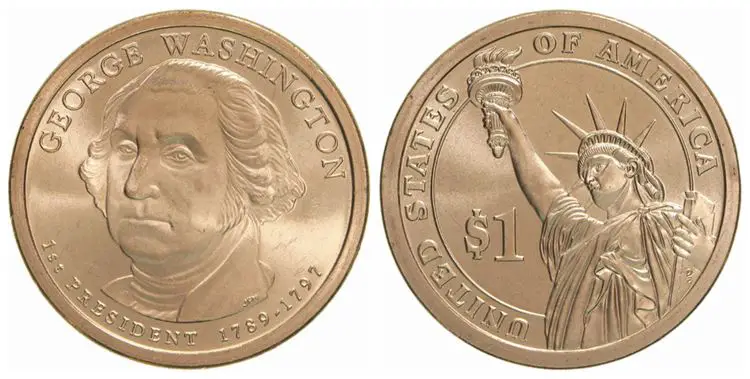
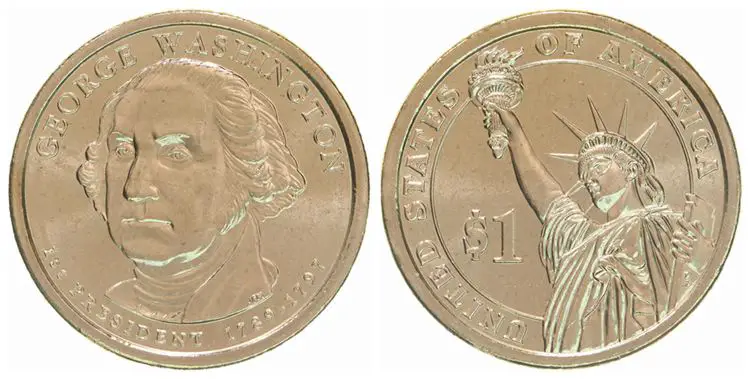
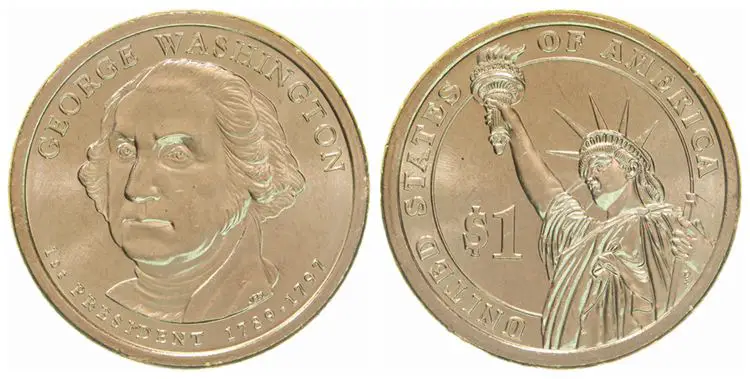
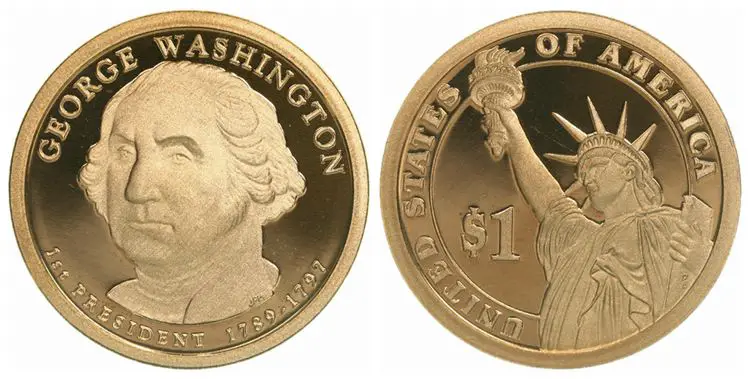
Senarat
Sunday 16th of July 2023
Both coins belongs to me, equally good.naked eye cannot catch any scratches or marks.cpin nos.1983 small d mint mark and 1979 small block d can be an error. Other lady coin is not relevant.